This recipe was originally shared in 2014. Since that time, I’ve experimented with ways to improve this recipe, based on my own experience and reader feedback. In 2017, I shared a new and update recipe. Check out the new recipe, here.
Remember those chocolate chip cookies I posted this week? Yes, those ooey-gooey little bites of pure joy. It’s time to draw it back a little, finish up that last little crumb smudged with chocolaty goodness and talk about teeth and toothpaste. I know, a bit of a downer topic after talking chocolate, but I promise, you’ll want to stick around.
Growing up, I regularly visited the dentist, received protective sealants, braces, and cleanings. You could say the dentist and I were quite the BFF’s, maybe more like BDF’s (Best Dental Friends). My teeth were well-cared for, thanks to my parents.
With as many dental treatments as I received over the years, you’d think my teeth would be cavity-free and gorgeous. Cavitiy-free? I have many. Gorgeous teeth? Well, they are nice looking. Not once did I ever stop to think about what I was putting on my teeth and how it effects those pearly whites. For nearly twenty-eight years, I never once thought there was a different way to care for teeth. After all, commercials, the dentist, and pamphlets, tell us we need commercial toothpaste, two times a day, followed by a thorough washing of bright-blue mouth wash. And if that commercial toothpaste irritates your teeth, then the industry will sell you “special” commercial toothpaste.
After delving into Dr. Weston A Price’s book, Nutrition and Physical Degeneration and changing our diet to include lots of good fat, quite the shocker for a former margarine-loving vegetarian, I realized food has the power to heal and restore health. The difference real food made for our tired bodies, our son’s Apraxia, and even our dental health was amazing. Even with the real food change I continued to use commercial, processed products for our personal hygiene.
Here’s the thing about real food, natural living, getting back to simple, whatever you want to call it, eventually you start questioning all products. One day you pick up that bottle of lotion, after enjoying a nice glass of kombucha, and wonder, “Why can’t I pronounce anything on this bottle?” Soon, that bottle gets tossed and you’re experimenting with the same coconut oil used to make brownies, rubbing it all over your dry legs.
It doesn’t stop there, soon you’re tossing the foundation powder and whipping up a cocoa mixture to apply to your face. That foundation powder leads to body wash, homemade neosporin, vapor rub, and laundry soap. Your medicine cabinet resembles a hodge podge of natural ingredients and little mason jars with the only labels being hand-written. Your husband lovingly calls you “the witch-doctor” and your friends call you “crazy”.
Don’t think it will happen, friends? Give it a bit of time. Soon, you’ll be there too.
Today, I’m sharing a new recipe. One you can easily whip up with that hodge podge of natural ingredients. A recipe to replace yet another chemical found in our homes, toothpaste. A homemade toothpaste that’s revolutionized my teeth and dental health. This recipe is made with benonite clay. The same clay used to make foundation powder, rich is potassium and calcium and effective at removing toxins. Baking soda and coconut oil help to whiten and clean teeth. Mineral-rich salt is also added. Stevia and peppermint essential oil add a delicate, sweet peppermint flavor to the salty mixture. Each ingredient comes together to create a homemade toothpaste that cleans and nourishes teeth, in a simple, chemical-free fashion.
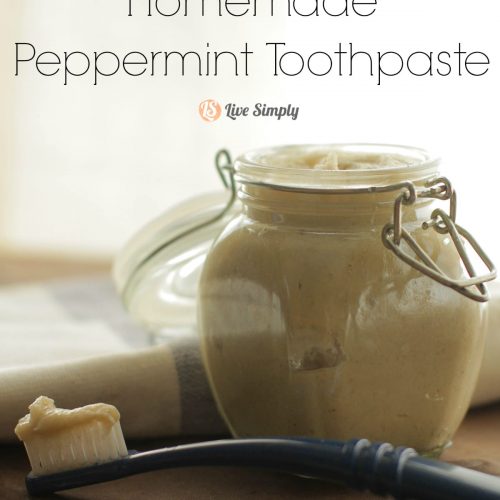
Simple Homemade Peppermint Toothpaste
Ingredients
- 3/8 cup coconut oil soft, but not liquid
- 1/4 cup baking soda
- 1/2 tsp salt
- 1 tsp bentonite clay
- 1/2 tsp liquid stevia optional
- 5-7 drops peppermint essential oil the amount will depend on taste preference
Instructions
- In a medium bowl, combine the coconut oil and baking soda. Mix thoroughly.
- Add the remaining ingredients and mix.
- Store in a jar and scoop with a small spoon (to prevent bacteria from entering the container). For a squeezable toothpaste, use a squeeze bottle.
- Note: When mixing bentonite clay, please use a wood or plastic spoon. Bentonite clay should not come in contact with metal because it deactivates the clay.
- The consistency of this recipe can vary depending on the temperature where the toothpaste is stored due to the nature of coconut oil.

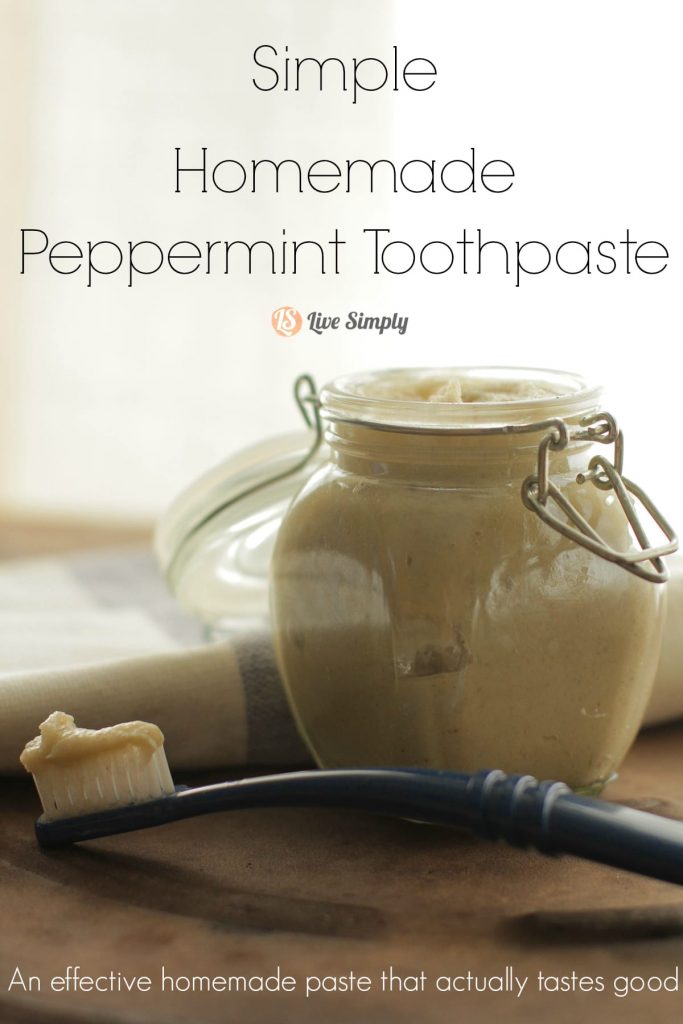
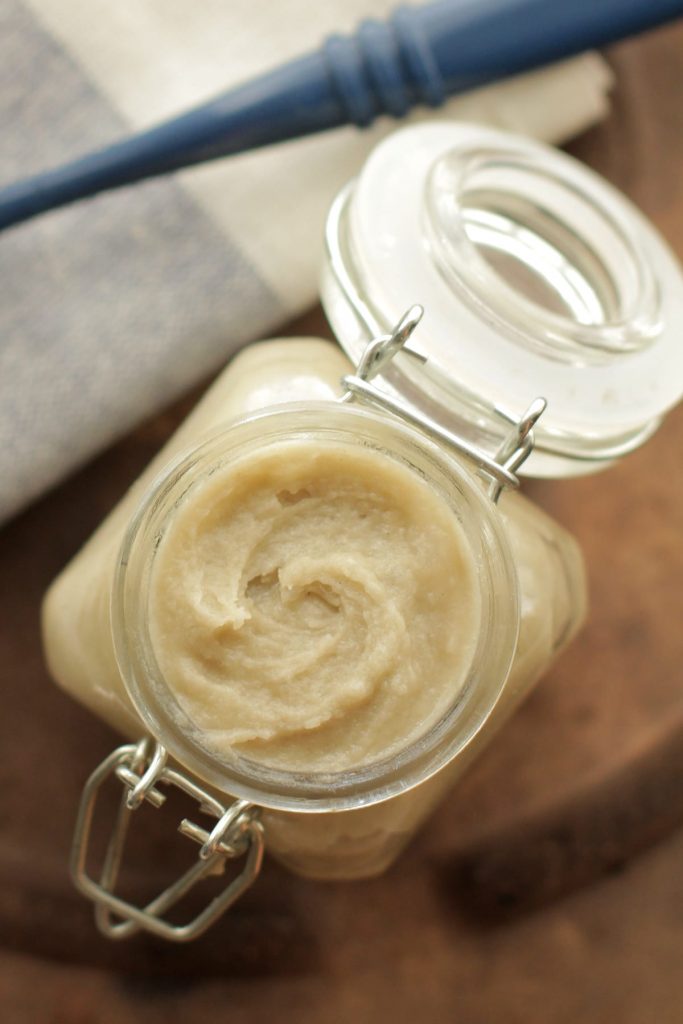
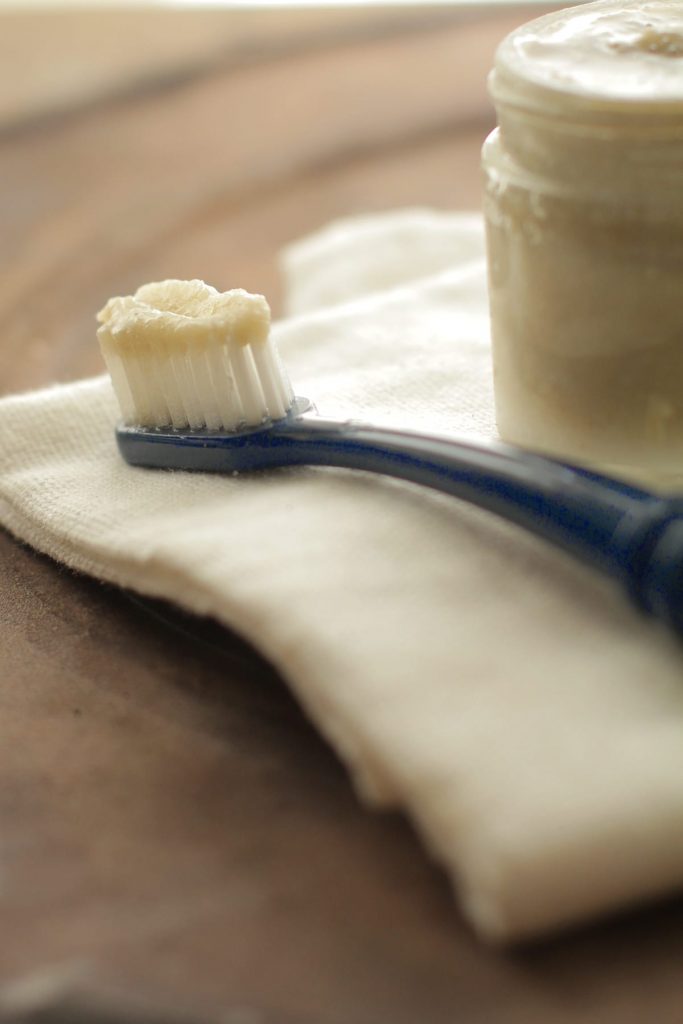
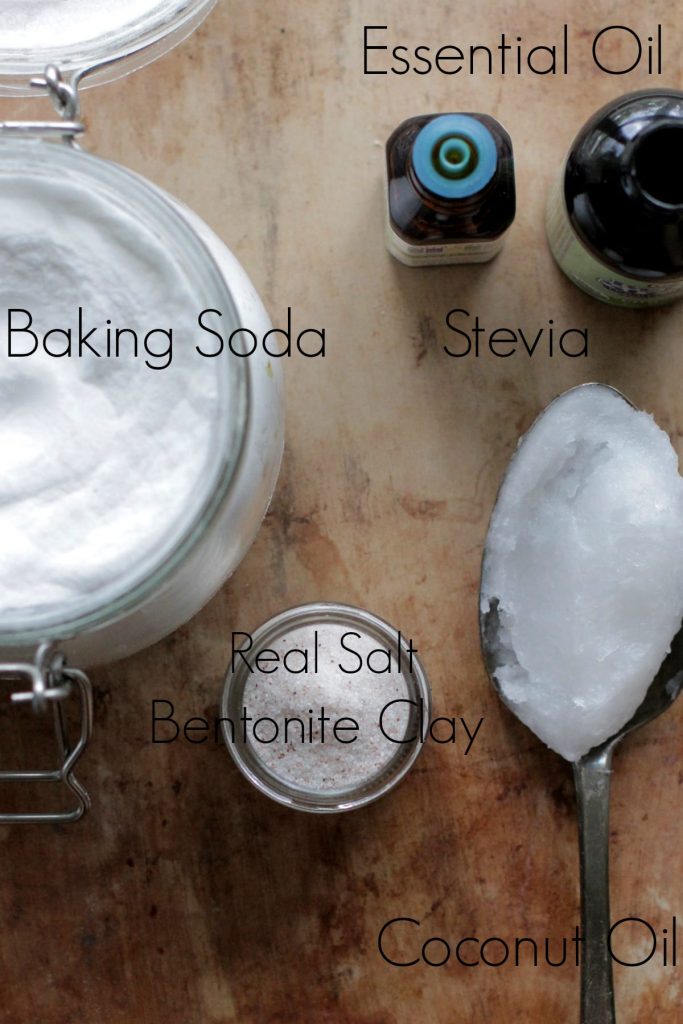
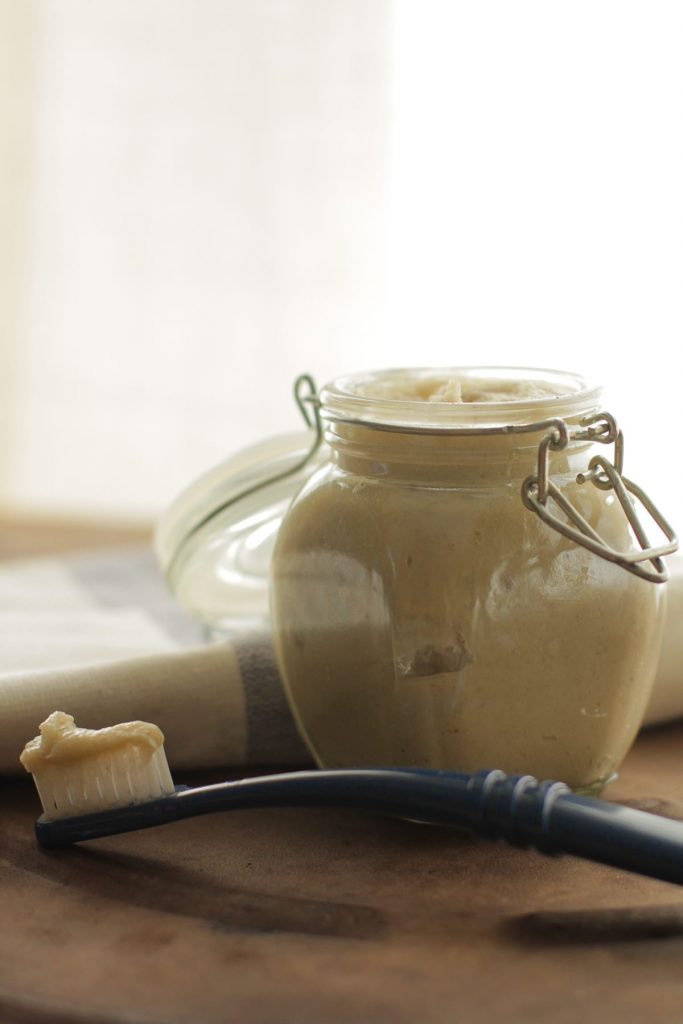
Thanks for sharing dental tips with us, They are very useful and does not cause any side effect. 🙂
Hey Dr. Susan, I’m glad you enjoyed reading about my experiences with homemade toothpaste :).
So I made a batch of the toothpaste and it’s great! I will say it does take a big of getting used to but I’m pleased so far. I think the next batch I will cut back on the baking soda and add some calcium carbonate (if that’s the right word) Thank you so much for posting your recipes for a simple life ☺️
Hey, I ordered NowFoods peppermint oil but then I saw a question about if it was food grade, I know you use Plant Therapy but is there some way to tell if it is food grade?
Hey Nicole, I wouldn’t recommend consuming essential oils intentionally, and I don’t think PT would call their oils food grade. Personally, as long as you’re not intentionally swallowing the toothpaste, I think NOW brand is fine.
Thanks
Hi! I love all of your recipes and DIYs, but this one didn’t turn out so well for me. It was great on day one. I made the adult and kid version and put them in go tubes. My ten year old wasn’t so fond of it, but I convinced him to use it anyway and it made our mouths nice and clean. Unfortunately, the next morning, the coconut oil and clay had separated in the bottle. I mixed them back together by squishing the bottle repeatedly, but the clay had hardened, so I had to open up the go-tube and stick a toothpick in it to get it to come out when squeezed. We still used it, but then a few days after that it was completely liquefied. I expected some difference in texture because of the coconut oil, but I figured the clay would help keep it all together! No such luck. Did I do something wrong? Do you have any advice for fixing these problems? I’m so confused!
I think I will definitely use glass jars for this toothpaste instead of the go tubes in the future. I wish the go tubes would work the way I had hoped they would, but I’d rather be able to remix because of melting and separating as needed. Otherwise, I think this recipe is great and really does get my teeth clean. And also come in handy for homemade hand sanitizer.
Hey Kimberly, I’m glad you’re enjoying the DIYs! I’m sorry this one didn’t turn out so well.
Truthfully, I’m not really sure what exactly may have happened to the toothpaste to cause the issues. There could be several factors, such as the outside temperature variations. If you have a photo(s) of the toothpaste, feel free to email me ([email protected]), and I can try to troubleshoot based on the photo(s).
Here are a few initial ideas:
I wonder if mixing the toothpaste first in a tupperware with a lid, covering it for about 24 hours, then resolving any issues with separation, and finally adding the toothpaste to the tube(s) in smaller amounts would help resolve the issue? That way you’re still getting the “squeezability” factor but in smaller amounts (let’s pretend that’s a real word ;)), and can stir the paste as needed in the jar. That may be more work, but may help initially, while still accomplishing the goal of a squeezable, homemade toothpaste.
Another idea is to put the GoTubes in a bowl of warm/hot water, and let the toothpaste inside soften. Then, stir or shake the bottles to combine the ingredients.
Finally, one more thought–if you’re using heat right now, the temperature may be melting the coconut oil during the night. Maybe store the bottles in a medicine cabinet or drawer where the heat won’t have such an effect on the toothpaste as it would on the countertop.
Also, if you go the jar route, definitely hold on to the GoTubes for other uses–they are also great if you ever pack something like waffles or pancakes and syrup in a lunchbox, or salad and dressing.
Hi Kristin! I have the same question as Shari (Oct. 7, 2015). I read through the comments but I couldn’t find an answer. “how does one clean the toothbrush? Due to the oil, rinsing it under water doesn’t do much and the brush is getting kind of unpleasant.” Thanks!
Hey Susie, I usually clean our toothbrushes in a cup of hot water every once in a while. I also replace our toothbrushes every couple of months.
Hi Kristin, thanks for the recipe. I was looking for a DIY toothpaste without water, as it’s hot and humid here and I had issues with mould with other recipes. However, when I tried this recipe I found it had an unpleasant tangy taste, and had a bit of a ‘fizz’. I think it’s because the baking soda is ‘reacting’ with the water/saliva in my mouth (gross, sorry). With other recipes that contain water, this ‘reaction’ has already occurred in the toothpaste, so it doesn’t happen in my mouth.
Am I crazy? Has anyone else found this?!
Thanks! Anna
Hey Anna, I can’t really speak to the fizz since I haven’t experienced this reaction, but it’s probably due to the baking soda. I’m not really sure what would cause the baking soda to fizz in your mouth. Usually when baking soda reacts to something acidic, like vinegar or lemon juice, it fizzes. Homemade toothpaste with baking soda and salt will have a tangy or salty taste, so that’s normal.
Kristin,
Thanks for being willing to share all your hard work. Am looking forward to making this but before I do, I was just wondering if Activated Charcoal Powder could be added for whitening?
Thx! Heidi
Hey Heidi, I haven’t tried adding ACP to this recipe, but I actually just bought some for experimenting :). I think it would be a great addition.
Huge advocate of natural remedies, and home made products in general. This sounds great, and I will definitely try it sometime soon. When made, I’m thinking of storing this in a jar of some sort. Would you recommend anything in particular?
Hey Aib, A jar would be great. That’s how I purchased natural toothpaste from local markets in our area, and how I store my “adult” toothpaste now that I make it at home.
I just found peppermint powder and now I want to make my own toothpaste. I think i might still add peppermint essential oil to be safe. I’ve never seen mineral rich salt as part of the ingredient for DIY toothpaste. What are some benefits of the salt? Thanks for sharing!
Hey Kate, I add the salt for minerals. Here’s more information about adding minerals to toothpaste. Some recipes add liquid trace minerals, but mineral-rich salt is always in my kitchen, so I go with the latter.
Hi Kristin
I tried without the additional salt, just baking soda and coconut oil. And the taste is really salty. Is that how it is suppose to taste? Anyway to make it less salty tasting for the kids? Thanks in advance!!! 🙂
Hey Ivy, Yes, homemade toothpaste is pretty salty. You can decrease the mineral-rich salt and work on increasing the amount each time you make a new batch. For the kids, I use this recipe: https://livesimply.me/2014/03/18/homemade-kid-toothpaste/. The recipe calls for less salt than my adult recipe.
Hello Miss Kristin,
Thank you for the recipe. Would you please help me understand: if toothpaste aims to clean the teeth, would the Stevia, as a sweetener, add sugars and therefore leave sugars left on the teeth?
Hey Madeline, The stevia is such a small amount in this recipe, but if you’d like to leave it out that’s totally fine. For a lot of people switching to homemade toothpaste is a big flavor difference, so adding stevia helps bridge the gap.
The bentonite clay – is it supposed to taste like dirt? I have some in a baggie, stuck in a drawer for a few years. Wasn’t sure if it is the drawer or the clay. Also, does it make your mouth a bit tingly?
I just tried it in my toothpowder (made with arrowroot, baking soda & salt) & my teeth definitely feel cleaner with just one brushing! I think I’ll try your recipe next.
Thanks ever so much for all you do. You have solved so many of my issues!
I got my answer – went ahead & ordered the clay & sure enough, it was the drawer. Ugh. Playing around with the recipe now, thanks!
That’s great, Carolyn! I’m glad you found the answer. Enjoy!!
Question … I know temperature is a huge factor in the ‘squeeze-ability’ of the toothpaste. I live in Memphis and the toothpaste is always too thick to squeeze – suggestions on what I might thin it with?
Hey Kay, Whipping the coconut oil with a hand-mixer, along with the other ingredients may help make this toothpaste a bit softer when it comes to cooler temps. Another option is to add more coconut, if the overall consistency is just too thick.
I made the recipe but it was too salty for me, my kids tried it and hated it unfortunately. I added a lot more coconut oil to cut the saltiness so I could use it . I think just using plain coconut oil and some peppermint oil is probably what I will be using once I am finished with this one.
Hey Lucy, Homemade toothpaste is definitely salty. The salt adds beneficial minerals, but if it’s too much, leaving the salt out is an option.
Hi Kristin, I am so, so happy I came across your blog and that is a direct result of my striving to replace all store-bought cosmetics and food and start making my own with homemade, natural ingredients. This is a wonderful toothpaste recipe, but I was wondering if you can replace the bentonite clay with green clay? I don’t think I can find bentonite clay in my country, so the closest thing to it is green clay. Are you familiar with the effect it might have on teeth? I read that it is antibacterial, helps against bad breath, mouth infections and dental abscess so it might be just right. What do you think? Thanks, Lily.
Hey Lily, Green clay will be just fine, I believe it’s the same as bentonite clay.
Hi! I was wondering if the stevia is necessary for this recipe or just optional to make the toothpaste sweet to taste? Thanks!
Hey Mallory, It’s completely optional. I just add it for sweetness since many people desire the commercial toothpaste taste.
Hello,
I have two questions, please. One, I have many crowns and receding gums due to the metals in the crowns. My dentist wants to remove them all and replace them with pure porcelain. ($!) I am trying this toothpaste (I like it) to see if the clay can pull the metal toxins out of my gums and help them be healthier. Will the metal in the crowns, which is visible at the bottom of some of the crowns, inactivate the clay? Thus, not helping me? And two, how does one clean the toothbrush? Due to the oil, rinsing it under water doesn’t do much and the brush is getting kind of unpleasant.
Thank you for very much for your time and reply, and you have a great website!
Shari
I was wondering, don’t you always use your homemade toothpaste, if not what is your favorite natural brand and flavor?
I am just about to make my second batch, I have clove bud oil and wanted to use it instead of peppermint. Have you ever tried it, I know clove is supposed to be a strong oil?
Hey Bethany, I regularly go between making my own toothpaste and purchasing store-bought toothpaste, depending on the season of life. When I purchase toothpaste, I really like Earthpaste from Redmond. I haven’t tried clove bud oil, but I’ve also heard great things about it. I think it’s a hot oil, so a little bit goes a long way.
If you put the toothpaste in a jar or pot, I suppose you have to dip your toothbrush into the paste to get it out, right? So, that just seems unsanitary. Has this occurred to anyone else? Did I miss some info about this recipe being antibacterial or something? Has anyone had any problems with this method?
I know you suggested an option of buying the GoToob, which would solve this issue, but I like the idea of the jar better – as long as it doesn’t become a germ factory on my counter.
I would appreciate any advice or enlightenment. Thanks. 🙂
Hey SuziCat,
I’ll admit, there have been times I’ve dipped my toothbrush into the jar. Yes, I know it isn’t the big move. I recommend keeping a small spoon near the jar, so you can scoop the toothpaste from the jar.
Are you concerned about the baking soda damaging your enamel? I just recently thought/heard about that.
Hey Adria, So far the baking soda hasn’t been a concern. My experience doesn’t mean people can’t experience issues. There are a couple of options if brushing regularly with the baking soda is a concern:
1. Decrease the baking soda in the recipe–use just 2 TB and increase the bentonite clay (if desired for consistency).
2. Take a break from using homemade toothpaste every few months to give your teeth a break from the baking soda and switch to a toothpaste like Earthpaste.